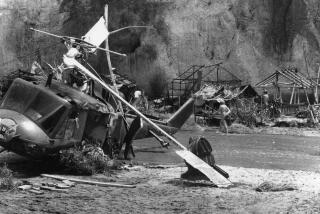Cult Classic Mystery : A new video release of ‘Kiss Me Deadly’ includes the now-famous lost footage. But how it got lost is still a riddle.
- Share via
“Kiss Me Deadly,” the 1955 film noir cult classic about the paranoia of the Atomic Age, is intact once again after enduring several decades with a mutilated ending--thanks to a film editor turned intrepid detective.
The newly discovered version, which screened a few months back at LACMA and can be seen at the New Beverly this Sunday through Aug. 19, makes its home video premiere today (courtesy of MGM Home Entertainment, with a wide-screen laserdisc to follow from Image Entertainment).
So now we can see for ourselves that Mike Hammer (Ralph Meeker) and girlfriend Velda (Maxine Cooper) flee into the ocean before the Malibu beach house explodes. But the ongoing debate concerning the outcome will continue. While the additional 64 seconds of footage clarifies their escape, does it really alter their fate? After all, it is a nuclear explosion.
And the biggest mystery of all--why the ending was trimmed--remains unsolved, because there is no apparent record that United Artists authorized it. You might say the circumstances are as strange and elusive as . . . the film’s “Great Whatsit.”
“Since the early ‘70s, all release prints have had the truncated ending,” explains Glenn Erickson, an editor at MGM who facilitated the discovery of the lost footage in January after an exhaustive search. “The more I read and looked at the stills, the more I thought something was done on purpose.”
Erickson’s curiosity actually began 25 years ago, when friend and film historian Alain Silver noticed odd discrepancies while inspecting frame enlargements from a 16-millimeter print. Shots he recalled from another source were missing. The familiar “va-va-voom!,” if you will, seemed to be lacking its “va-va.” Erickson, a devoted fan, was determined to see the original ending.
During the ‘80s, the editor made a point of viewing every revival of “Kiss Me Deadly.” But the result was always the same: All prints contained the truncated ending. (Original prints, though scarce, reputedly existed.)
In 1992, the two friends revisited the controversy when Silver found references to the original ending in an English magazine. (Around the same time, they noticed that the “Kiss Me Deadly” laserdisc included a foreign trailer with one of the missing shots of Hammer and Velda struggling in the surf.)
Last year, with Erickson at MGM, he was finally in a position to inspect the studio’s negative. He discovered that even the negative had been altered.
“I had one last hope. [“Kiss Me Deadly” director] Robert Aldrich’s personal print. Since Alain wrote a biography of Aldrich, I asked him if he knew where it was.”
*
Knowing the answer all along without realizing it, Silver contacted the Directors Guild, where Aldrich’s original print was donated after his death in 1983. He then obtained permission to borrow the print from the UCLA Film and Television Archive, where it was stored.
“You can imagine how excited we were,” Erickson says, beaming. “They sent us the print, and we watched it--and it was the same ending. We were ready to give up when we realized they sent the wrong print! There were actually two prints at UCLA, and this one was incorrectly labeled as Aldrich’s. They sent over the other one and it had the complete ending!”
(A new duplicate negative with the original ending has since been constructed by archivist John Kirk. The new home video version, meanwhile, includes the truncated ending for comparison.)
“I always thought someone mishandled the negative,” Silver suggests. “Nobody took [the ending] out on purpose. You can tell someone broke the negative. The print quality worsens, there are awkward jump cuts, the music is chopped off. The most obvious thing is, that whoever did it made a new optical end title to cover himself.
“Ironically, [the truncated sequence] hardens the ending, making it apocryphal. They don’t survive.”
*
In keeping with the prevailing paranoia, some prefer to think “Kiss Me Deadly” was mishandled for censorship reasons, including Erickson. A failure when originally released, the film was denounced by the influential Kefauver Commission for its violence. Aldrich even sold his rights back to UA in 1959 when he needed the money.
“I believe the negative wasn’t botched,” Erickson counters. “John [Kirk] found an Italian print without sound that had the complete ending in a studio vault in Philadelphia. . . . That proves to me that if someone made a mistake, they had the materials to fix it right.
“I believe there was censorship pressure at the distribution level and the negative was tampered with quietly. Aldrich wrote an article, ‘In Defense of Sex and Violence,’ where he described censorship pressure on his films. Maybe to sell the picture in certain regions, they were pressured to have Hammer punished--so it ends with the explosion before they leave the beach house.”
Silver, however, disagrees with his friend: “I never asked Aldrich when he was alive, but he told others that he had no idea the sequence was cut. The big censorship question was the ‘Rather Have the Blues’ bar scene, with a singer holding the microphone phallically. Aldrich prevailed.
“It’s ironic that ‘Kiss’ should suffer this fate--it was Aldrich’s personal favorite--and it’s ironic that it should happen to Aldrich. When he was DGA president in 1978, he was involved in negotiating the most comprehensive artist rights contract in guild history. . . . He introduced concepts from his own contracts.”
“Kiss Me Deadly,” like so many B-films of the period, was rediscovered in the ‘60s with the coming of the auteur theory and the French New Wave. Cineastes were awe-struck at the filmy cool brutality and hip anarchy (the reverse opening title crawl--not to mention the disjointed false ending).
*
Just don’t ascribe authorship to Aldrich, insists A.I. Bezzerides, the film’s crusty 89-year-old screenwriter. “[Francois] Truffaut called me up in Paris once and wanted to know who did what,” he recalls. “I said, ‘What do you wanna know about that?’
“I told him I was the writer. I was responsible for the nuclear energy, locations like Angel’s Flight, the unseen evil and the poem ‘Remember, Me’ which gets Hammer to care about the girl. And Truffaut said, ‘Aldrich isn’t the New Wave director, you are.’ ”
Bezzerides agrees the original ending is integral, but now cautions against any hopeful interpretation: “They’re watching the house explode together. We’re watching it with them. They’re in the water scared to death, watching the world end.”
More to Read
Only good movies
Get the Indie Focus newsletter, Mark Olsen's weekly guide to the world of cinema.
You may occasionally receive promotional content from the Los Angeles Times.










